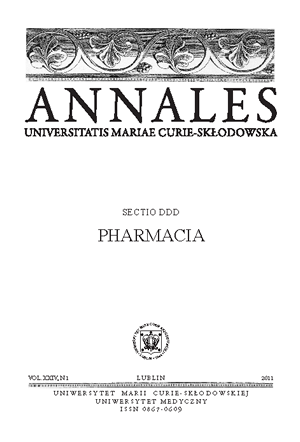Essential oil from fruits of Angelica officinalis and its antibacterial activity
Keywords:
Angelica officinalis, essential oil, antibacterial activity, GC-MSAbstract
The essential oil from the fruits of Angelica officinalis, collected in the botanical garden in Poland, was obtained by hydrodistillation (HD) techniques and analyzed using GC-MS. A total of 30 components were identified. The most abundant compound was β-phellandrene (73%). The minimal inhibitory concentration of essentials oil, defined as the lowest concentration able to inhibit visible microbial growth, and the minimal bactericidal concentration, the lowest concentration required to kill of the bacteria, were determined using the broth microdilution method and plating on agar. Essential oil showed moderate antibacterial activity against all reference strains. There was only a small difference between power of activity against Gram-positive and Gram-negative bacteria with MICs ranging from 0.62 to 1.25 mg/ml and 1.25 to 2.5 mg/ml, respectively.
References
1. Adams R.P.: Identification of Essential Oil Components by Gas Chromatography/Mass Spectroscopy’ Allured Publishing Corp., Carol Stream, IL, USA 2001.
2. Bernard C.: Essential oils of three Angelica L. species growing in France. Part II: Fruit oils. J. Essent. Oil, 13, 260, 2001.
3. Bogucka-Kocka A., Smolarz H.D., Kocki J.: Apoptotic activities of ethanol extracts from some Apiaceae on human leukaemia cell lines. Fitoterapia, 79, 487, 2008.
4. Burt S.: Essential oils: their antibacterial properties and potential applications in foods—a review. Intern. J. Food Microbiol., 94, 223, 2004.
5. Glowniak K., Gawron A., Kwietniewska B.: Investigations on coumarins of Archangelica officinalis Hoffm. Fruits.: Annales UMCS Sect. D Medicina, 31, 349, 1976.
6. Holm Y., Vuorela P., Hiltunen R.: Enantiomeric composition of monoterpene hydrocarbons in n-hexane extracts of Angelica archangelica L. roots and seeds. Flav. Frag. J., 12, 397, 1997.
7. Howes M.R., Perry S.L., Houghton P.J.: Plants with traditional uses and activities, relevant to the management of Alzheimer's disease and other cognitive disorders. Phytother. Res., 17, 1, 2003.
8. Lopes D., Strobl H., Kolodziejczyk P.: 14-Methylpentadecano-15-lactone (muscolide): a new macrocyclic lactone from the oil of Angelica archangelica L. Chem. Biodiver., 1, 1880, 2004.
9. Luszczki J.J., Głowniak K., Czuczwar S.J.: Imperatorin enhances the protective activity of conventional antileptic drugs against maximal electroshock-induced seizures in mice. Eur. J. Pharmacol., 574, 133, 2007.
10. Luszczki J.J., Głowniak K., Czuczwar S.J.: Time-course and dose-response relationships of imperatorin in the mouse maximal electroshock seizure threshold model. Neurosci. Res., 59, 18, 2007.
11. Muller M. et al.: 2D NMR spectroscopic analyses of archangelicin from the seeds of Angelica archangelica. Acta Pharm., 54, 277, 2004.
12. Nivinskiene O., Butkiene R., Mockute D.: The seed (fruit) essential oils of Angelica archangelica L. growing wild in Lithuania. J. Essent. Oil, 19, 477, 2007.
13. Polish Pharmacopoea VI, Polish Pharmaceutical Society, Warsaw 2002.
14. Roos G. et al.: Isolation, identification and screening for COX-1- and 5-LO-inhibition of coumarins from Angelica archangelica. Pharm. Pharmacol. Lett., 7, 157, 1997.
15. Sarker S.D., Nahar L.: Natural Medicine: The Genus Angelica. Curr. Med. Chem., 11, 1479, 2004.
16. Schelz Z., Molnar J., Hohmann J.: Antimicrobial and antiplasmid activities of essential oils. Fitoterapia, 77, 279, 2006.
17. Sigurdsson S., Ögmundsdottir H.M., Gudbjarnason S.: The cytotoxic effect of two chemotypes of essential oils from the fruits of Angelica archangelica L. Anticancer Res., 25, 1877, 2005.
18. Skalicka-Woźniak K. et al.: Antimicrobial activity of fatty acids from fruits of Peucedanum cervaria and P. alsaticum. Chem. Biodiv., 7, 2748, 2010.
19. Skalicka-Woźniak K. et al.: Comparison of hydrodistillation and headspace solid-phase microextraction techniques for antibacterial volatile compounds from the fruits of Seseli libanotis. Nat. Prod. Commun., 5, 1427, 2010.
20. Tutin T.G. et al.: Flora Europaea, Rosaceae to Umbelliferae. Cambridge Univeristy Press, II, 1968, page 357.
21. Waksmundzka–Hajnos M. et al: Effect of extraction method on the yield of furanocoumarins from fruits of Archangelica officinalis Hoffm. Phytochem. Anal., 15, 1, 2004.
Downloads
Published
Issue
Section
License
Copyright (c) 2011 Authors

This work is licensed under a Creative Commons Attribution-NonCommercial-NoDerivatives 3.0 Unported License.


